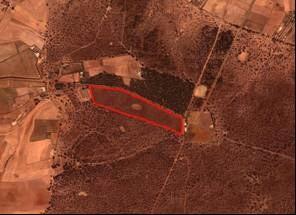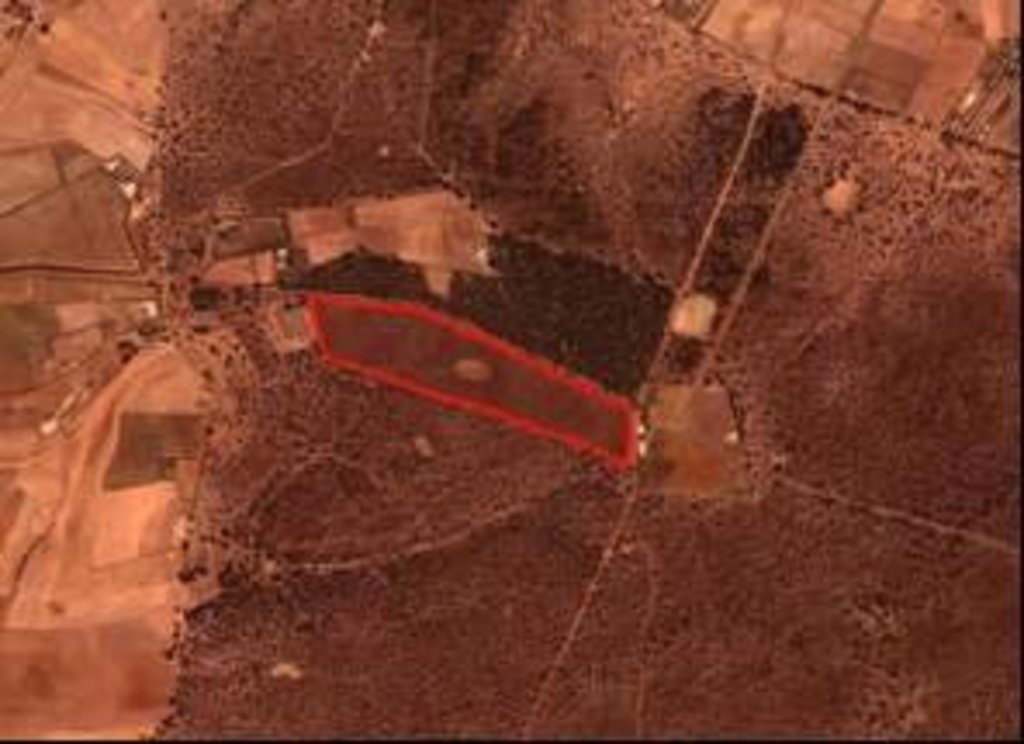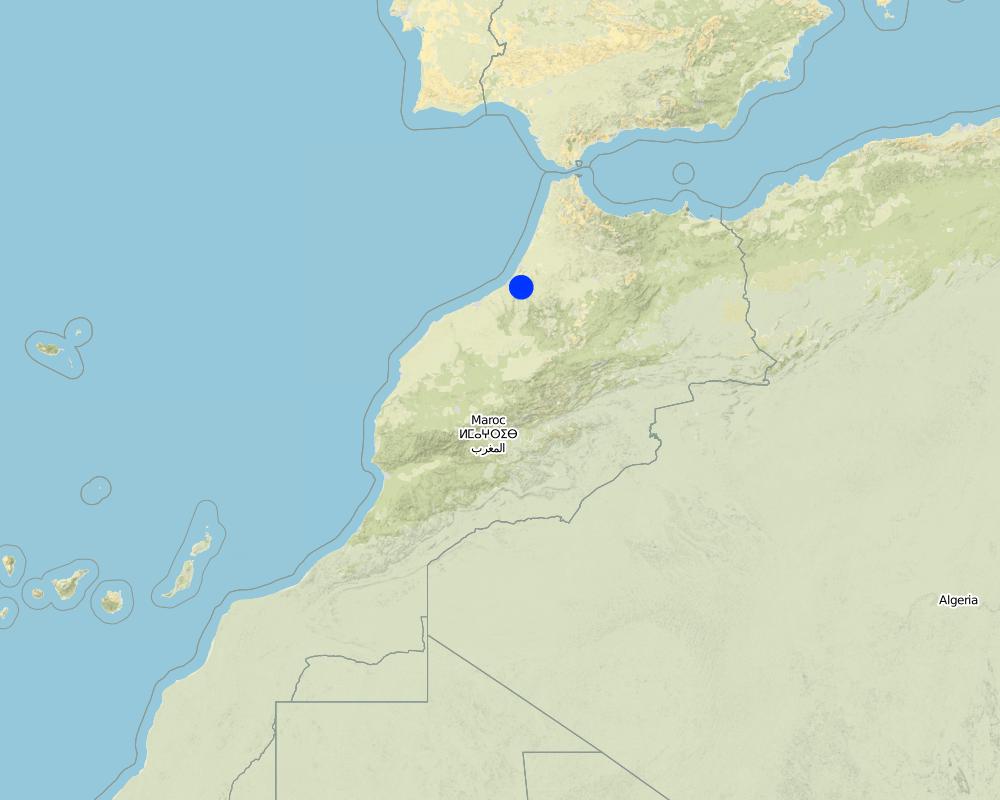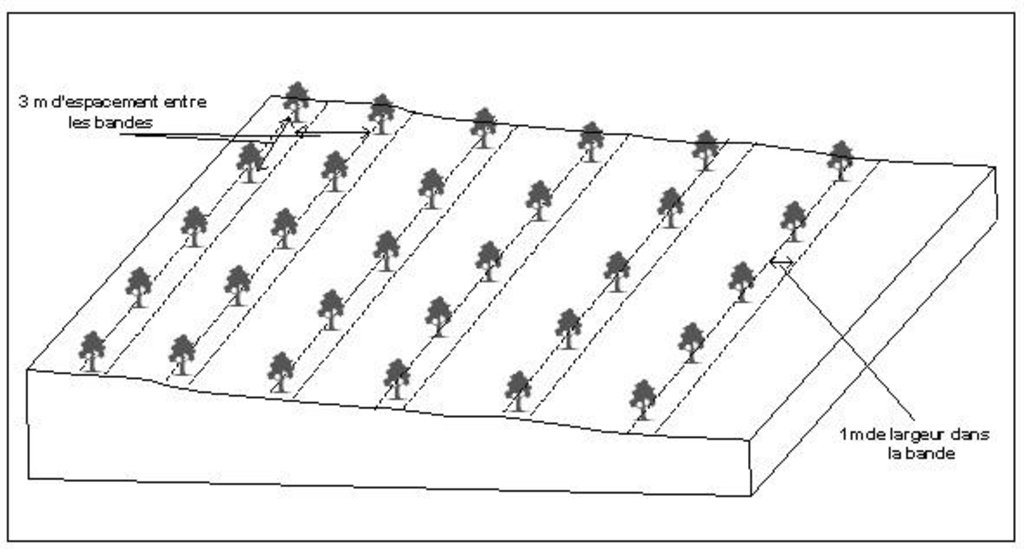Assisted cork oak regeneration [Morocco]
- Creation:
- Update:
- Compiler: Miloud Chaker
- Editor: –
- Reviewers: Deborah Niggli, Alexandra Gavilano
Takhlif Madoum Elghaba (arabic)
technologies_1428 - Morocco
View sections
Expand all Collapse all1. General information
1.2 Contact details of resource persons and institutions involved in the assessment and documentation of the Technology
Name of project which facilitated the documentation/ evaluation of the Technology (if relevant)
DESIRE (EU-DES!RE)Name of the institution(s) which facilitated the documentation/ evaluation of the Technology (if relevant)
Université Mohammed V Agdal, Faculté des Lettres (Université Mohammed V Agdal, Faculté des Lettres)1.3 Conditions regarding the use of data documented through WOCAT
The compiler and key resource person(s) accept the conditions regarding the use of data documented through WOCAT:
Yes
1.4 Declaration on sustainability of the described Technology
Is the Technology described here problematic with regard to land degradation, so that it cannot be declared a sustainable land management technology?
No
1.5 Reference to Questionnaire(s) on SLM Approaches (documented using WOCAT)
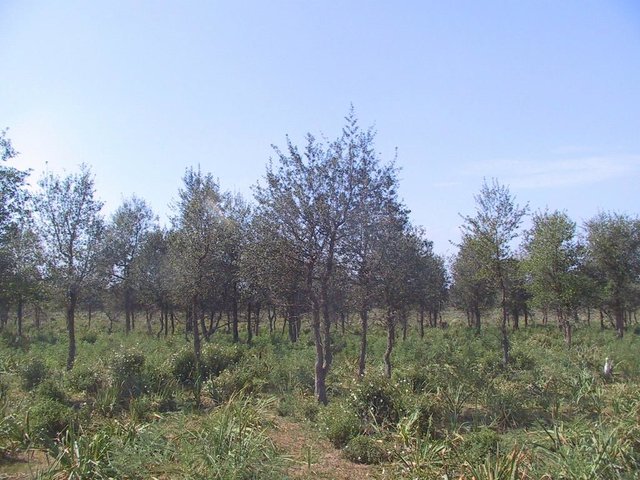
Régénération assistée du chêne liège [Morocco]
La régénération assistée a été réalisée dans le cadre d’une approche globale visant le renouvellement des espaces forestiers sensibles selon la réalisation des programmes et projets menés depuis 1970 dans le cadre du PNR (Programme National de Reboisement).
- Compiler: Miloud Chaker
2. Description of the SLM Technology
2.1 Short description of the Technology
Definition of the Technology:
Assisted cork oak regeneration in the Sehoul forest, by acorn seeding and seedling plantation (derived from a plant nursery), involving careful husbandry and protection from grazing
2.2 Detailed description of the Technology
Description:
Because of the accelerated degradation of the Sehoul forest and the difficulties with natural regeneration, the Moroccan State has planned and adopted a policy, based on a global and integrated view. The preservation of forests is an important topic for socio-economic development. The National Plan for Reforestation defines the main lines of the national reforestation strategy and is the framework for the implementation of this technology.
The goal of this technology is to prepare plots where acorns should be sown or cork oak seedlings from plant nurseries planted. These test plots are guarded, maintained and watered to allow young plants to grow. Thus, cork oak regeneration ensures the continued existence and development of the forest. It conserves soil and water and fights against desertification. There are several benefits such as cork production, wood production, fodder production and better soil cover. Furthermore this technology positively impacts the socio-economic development of local populations, and services production (landscape, welfare and recreation) for urban populations.
The implementation of this technology needs the following activities: in general, good quality acorns and seedlings are required. Seedlings should come from the same region where they are planted and be certified by the authorities. An initial step in implementation is the clearing and shredding of small, woody plants. Soil preparation consists of 30 cm deep ploughing to loosen the topsoil, and to allow easier root growth. Then rows of pits are dug. Generally, it is crucial to apply correct plantation and seedling according to the season (winter), to ensure a depth of 50 cm in the planting hole, and to water copiously after planting to ensure a good contact between the soil and roots. A fence installed to protect areas from grazing is temporarily required until the trees are robust enough to cope with browsing cattle. The enclosure period usually lasts a minimum of 6 years.
The natural condition is semi-arid with precipitation ranging from 350 to 450 mm per year. The underlying geology consists of quartzite and sandstone, covered by marl. Soils are varied, but the main types are hydromorph and ferrous. Socially, the Sehoul forest is populated by poor farmers, strongly dependent on forest resources (fodder and firewood). The forest is owned by the government, but managed by local communities, who benefit from its use (marketing of cork, pharmaceutical products, charcoal, etc.). The rights of free forest exploitation for the local population are a political problem which needs to be resolved in order to achieve good forest management. Economically, the contribution of forestry to the GDP is low, but its environmental role is essential.
2.3 Photos of the Technology
2.5 Country/ region/ locations where the Technology has been applied and which are covered by this assessment
Country:
Morocco
Region/ State/ Province:
Salé
Further specification of location:
Sehoul
Specify the spread of the Technology:
- evenly spread over an area
If the Technology is evenly spread over an area, specify area covered (in km2):
0.2
Comments:
Total area covered by the SLM Technology is 0.2 km2.
Cork oak regeneration through assisted regeneration in order to ensure the continued existence of cork oak forests. This activity is still in an experimental phase.
Map
×2.6 Date of implementation
If precise year is not known, indicate approximate date:
- more than 50 years ago (traditional)
2.7 Introduction of the Technology
Specify how the Technology was introduced:
- during experiments/ research
Comments (type of project, etc.):
Forest research initiated in 1950 and management plan.
3. Classification of the SLM Technology
3.1 Main purpose(s) of the Technology
- conserve ecosystem
3.2 Current land use type(s) where the Technology is applied

Forest/ woodlands
- (Semi-)natural forests/ woodlands
- Tree plantation, afforestation
(Semi-)natural forests/ woodlands: Specify management type:
- Shifting cultivation
Tree plantation, afforestation: Specify origin and composition of species:
- Monoculture local variety
- cork oak
Products and services:
- Fuelwood
- Other forest products
- Grazing/ browsing
- Nature conservation/ protection
- Recreation/ tourism
- cork oak exploitation
Comments:
Major land use problems (compiler’s opinion): Forest ageing and degradation processes can lead to desertification
Major land use problems (land users’ perception): Reforesting is positive, but resting areas are seen as negative because land users cannot access the resources during 5 to 6 years.
Plantation forestry: plantation in empty spaces and in sparse forest
Livestock density: > 100 LU /km2
3.4 Water supply
Water supply for the land on which the Technology is applied:
- rainfed
3.5 SLM group to which the Technology belongs
- forest plantation management
- rotational systems (crop rotation, fallows, shifting cultivation)
3.6 SLM measures comprising the Technology

vegetative measures
- V1: Tree and shrub cover
Comments:
Type of vegetative measures: aligned: -contour
3.7 Main types of land degradation addressed by the Technology

soil erosion by water
- Wt: loss of topsoil/ surface erosion

physical soil deterioration
- Pc: compaction

biological degradation
- Bc: reduction of vegetation cover
Comments:
Main causes of degradation: over-exploitation of vegetation for domestic use, urban capital invested in excessive livestock, roads, unorganized tourism and leisure
Secondary causes of degradation: urbanisation and infrastructure development, land tenure (Treatment recommended fot th plots are not respected), poverty / wealth (overexploitation of forest resources), inputs and infrastructure: (roads, markets, distribution of water points, other, …) (lack of material, equipment and financing)
3.8 Prevention, reduction, or restoration of land degradation
Specify the goal of the Technology with regard to land degradation:
- prevent land degradation
- reduce land degradation
4. Technical specifications, implementation activities, inputs, and costs
4.1 Technical drawing of the Technology
Technical specifications (related to technical drawing):
Contour planting in strips where Cistus has been removed (in order to allow more light and avoid competition for moisture)
Technical knowledge required for field staff / advisors: moderate
Main technical functions: improvement of ground cover, increase in organic matter, increase of biomass (quantity), promotion of vegetation species and varieties (quality, eg palatable fodder)
Secondary technical functions: increase of surface roughness, stabilisation of soil (eg by tree roots against land slides), increase of infiltration, increase / maintain water stored in soil
Aligned: -contour
Vegetative material: T : trees / shrubs
Number of plants per (ha): 1111
Spacing between rows / strips / blocks (m): 3
Vertical interval within rows / strips / blocks (m): 3
Width within rows / strips / blocks (m): 1
Trees/ shrubs species: cork oak
Author:
Chaker Miloud, Rabat, Maroc
4.2 General information regarding the calculation of inputs and costs
other/ national currency (specify):
dirhams
If relevant, indicate exchange rate from USD to local currency (e.g. 1 USD = 79.9 Brazilian Real): 1 USD =:
8.0
Indicate average wage cost of hired labour per day:
5.00
4.3 Establishment activities
| Activity | Timing (season) | |
|---|---|---|
| 1. | Soil preparation, weeding | once in October-November |
| 2. | Ploughing and digging planting pits | once in October-November |
| 3. | Plantation and watering | once in October-November |
| 4. | Fencing | once in October-November |
| 5. | Reduction of density, replacement of weak / dead plants | Spring |
4.4 Costs and inputs needed for establishment
| Specify input | Unit | Quantity | Costs per Unit | Total costs per input | % of costs borne by land users | |
|---|---|---|---|---|---|---|
| Labour | labour | ha | 1.0 | 435.0 | 435.0 | |
| Plant material | seeds | ha | 1.0 | 208.25 | 208.25 | |
| Construction material | cultivation and weeding | ha | 1.0 | 125.0 | 125.0 | |
| Total costs for establishment of the Technology | 768.25 | |||||
| Total costs for establishment of the Technology in USD | 96.03 | |||||
Comments:
Duration of establishment phase: 12 month(s)
4.5 Maintenance/ recurrent activities
| Activity | Timing/ frequency | |
|---|---|---|
| 1. | Weeding and ploughing | Spring and early summer |
| 2. | Watering (first two years) | October-November and early spring |
| 3. | Guarding | October-November |
4.6 Costs and inputs needed for maintenance/ recurrent activities (per year)
| Specify input | Unit | Quantity | Costs per Unit | Total costs per input | % of costs borne by land users | |
|---|---|---|---|---|---|---|
| Labour | labour | ha | 1.0 | 35.0 | 35.0 | |
| Construction material | cultivation and weeding | ha | 1.0 | 125.0 | 125.0 | |
| Total costs for maintenance of the Technology | 160.0 | |||||
| Total costs for maintenance of the Technology in USD | 20.0 | |||||
4.7 Most important factors affecting the costs
Describe the most determinate factors affecting the costs:
If planting coincides with a dry season, it takes watering on several occasions, which makes applying the technology more expensive - Stronger fences and more supervising are required if near to habitation.
5. Natural and human environment
5.1 Climate
Annual rainfall
- < 250 mm
- 251-500 mm
- 501-750 mm
- 751-1,000 mm
- 1,001-1,500 mm
- 1,501-2,000 mm
- 2,001-3,000 mm
- 3,001-4,000 mm
- > 4,000 mm
Specifications/ comments on rainfall:
512 mm per year, with strong irregularities
Agro-climatic zone
- sub-humid
- semi-arid
Thermal climate class: subtropics
5.2 Topography
Slopes on average:
- flat (0-2%)
- gentle (3-5%)
- moderate (6-10%)
- rolling (11-15%)
- hilly (16-30%)
- steep (31-60%)
- very steep (>60%)
Landforms:
- plateau/plains
- ridges
- mountain slopes
- hill slopes
- footslopes
- valley floors
Altitudinal zone:
- 0-100 m a.s.l.
- 101-500 m a.s.l.
- 501-1,000 m a.s.l.
- 1,001-1,500 m a.s.l.
- 1,501-2,000 m a.s.l.
- 2,001-2,500 m a.s.l.
- 2,501-3,000 m a.s.l.
- 3,001-4,000 m a.s.l.
- > 4,000 m a.s.l.
5.3 Soils
Soil depth on average:
- very shallow (0-20 cm)
- shallow (21-50 cm)
- moderately deep (51-80 cm)
- deep (81-120 cm)
- very deep (> 120 cm)
Soil texture (topsoil):
- coarse/ light (sandy)
- medium (loamy, silty)
Topsoil organic matter:
- high (>3%)
- medium (1-3%)
5.4 Water availability and quality
Ground water table:
5-50 m
Availability of surface water:
good
Water quality (untreated):
good drinking water
5.5 Biodiversity
Species diversity:
- low
5.6 Characteristics of land users applying the Technology
Market orientation of production system:
- mixed (subsistence/ commercial)
Off-farm income:
- less than 10% of all income
Relative level of wealth:
- poor
- average
Individuals or groups:
- employee (company, government)
Indicate other relevant characteristics of the land users:
Population density: 10-50 persons/km2
Annual population growth: < 0.5%
5% of the land users are rich and own 15% of the land.
80% of the land users are average wealthy and own 80% of the land.
1% of the land users are poor and own 5% of the land.
1% of the land users are poor.
5.7 Average area of land used by land users applying the Technology
- < 0.5 ha
- 0.5-1 ha
- 1-2 ha
- 2-5 ha
- 5-15 ha
- 15-50 ha
- 50-100 ha
- 100-500 ha
- 500-1,000 ha
- 1,000-10,000 ha
- > 10,000 ha
5.8 Land ownership, land use rights, and water use rights
Land ownership:
- state
Land use rights:
- communal (organized)
Water use rights:
- open access (unorganized)
Comments:
In Morocco, forest belongs to the State but the population has the right to perform pastoral activities, to gather wood, to collect aromatic and medicinal plants, acorns, etc.)
5.9 Access to services and infrastructure
health:
- poor
- moderate
- good
education:
- poor
- moderate
- good
technical assistance:
- poor
- moderate
- good
employment (e.g. off-farm):
- poor
- moderate
- good
energy:
- poor
- moderate
- good
roads and transport:
- poor
- moderate
- good
drinking water and sanitation:
- poor
- moderate
- good
6. Impacts and concluding statements
6.1 On-site impacts the Technology has shown
Socio-economic impacts
Production
crop production
Quantity before SLM:
606 Kg/ha
Quantity after SLM:
4537 Kg/ha
fodder production
animal production
Comments/ specify:
in the long-term
wood production
Socio-cultural impacts
health situation
Comments/ specify:
in the case of a generalized regeneration
community institutions
Comments/ specify:
in the case of a generalized regeneration
national institutions
Comments/ specify:
in the case of a generalized regeneration
SLM/ land degradation knowledge
Comments/ specify:
in the case of a generalized regeneration
Conflict resolution and reduction
Comments/ specify:
in the case of a generalized regeneration
contribution to human well-being
Comments/ specify:
In the long term. It is too early to assess the technology impacts on the livelihood.
Ecological impacts
Water cycle/ runoff
surface runoff
groundwater table/ aquifer
Soil
soil moisture
Quantity before SLM:
2,5%
Quantity after SLM:
7,7%
soil loss
soil crusting/ sealing
soil organic matter/ below ground C
Biodiversity: vegetation, animals
animal diversity
Quantity before SLM:
12 species
Quantity after SLM:
23 species
6.2 Off-site impacts the Technology has shown
downstream flooding
downstream siltation
wind transported sediments
damage on neighbours' fields
damage on public/ private infrastructure
6.3 Exposure and sensitivity of the Technology to gradual climate change and climate-related extremes/ disasters (as perceived by land users)
Climate-related extremes (disasters)
Climatological disasters
| How does the Technology cope with it? | |
|---|---|
| drought | not well |
6.4 Cost-benefit analysis
How do the benefits compare with the establishment costs (from land users’ perspective)?
Short-term returns:
negative
Long-term returns:
positive
How do the benefits compare with the maintenance/ recurrent costs (from land users' perspective)?
Short-term returns:
negative
Long-term returns:
positive
6.5 Adoption of the Technology
Comments:
Demonstration plot implemented by the government, but not applied by the local communities yet.
6.7 Strengths/ advantages/ opportunities of the Technology
| Strengths/ advantages/ opportunities in the land user’s view |
|---|
| Improved fodder production in the long term |
| Strengths/ advantages/ opportunities in the compiler’s or other key resource person’s view |
|---|
| Natural resources conservation and fight against desertification |
| Cork oak regeneration in order to ensure the existence of cork oak forests |
| Improve sylvo-pastoral activities |
| Cork production enhancement |
6.8 Weaknesses/ disadvantages/ risks of the Technology and ways of overcoming them
| Weaknesses/ disadvantages/ risks in the land user’s view | How can they be overcome? |
|---|---|
| Forest users ask for subsidies in case of resting processes | Define the beneficiaries for the forest exploitation and its rules, its calendar and its rest areas by founding associations and unions |
| For land users, the forest potential by pastoral activities needs to be improved by seeding of palatable species | farmers must be included in the choice of implemented species |
| Weaknesses/ disadvantages/ risks in the compiler’s or other key resource person’s view | How can they be overcome? |
|---|---|
| Problems because of the high cost of this technology (about 8000 dh/ha, 1000 US$) | Costs can be reduced if population commit to respect the converted plots, even without fences and guards. |
| Maîtriser la charge d’équilibre dans les parcours forestiers en accord avec les paysans | |
| Définir les ayants droits à l’usage de la forêt, et les règles de son utilisation, le calendrier d’usage, les secteurs à mettre en repos |
7. References and links
7.1 Methods/ sources of information
- field visits, field surveys
- interviews with land users
When were the data compiled (in the field)?
19/08/2008
7.2 References to available publications
Title, author, year, ISBN:
Project PMVB 2001, Ministère d’agriculture de Maroc
Links and modules
Expand all Collapse allLinks

Régénération assistée du chêne liège [Morocco]
La régénération assistée a été réalisée dans le cadre d’une approche globale visant le renouvellement des espaces forestiers sensibles selon la réalisation des programmes et projets menés depuis 1970 dans le cadre du PNR (Programme National de Reboisement).
- Compiler: Miloud Chaker
Modules
No modules


